Sports are an important part of life. Unfortunately, injuries are common during sports. Dr. Anthony Yi has undergone extensive training to take care of the injured athlete. His goal is to get you back to the activities that you love quickly and also with your long-term future in mind.
Even though he is a surgeon, Dr. Yi will help you through your injury whether it requires surgery or not. In fact, most sports injuries do not require surgery. If you do need surgery, Dr. Yi is passionate about using state-of-the-art, minimally invasive techniques to accelerate your recovery and to help you achieve the results you need.
Learn more about some of the many sports injuries Dr. Yi can help you recover from.
Achilles Tendon Rupture
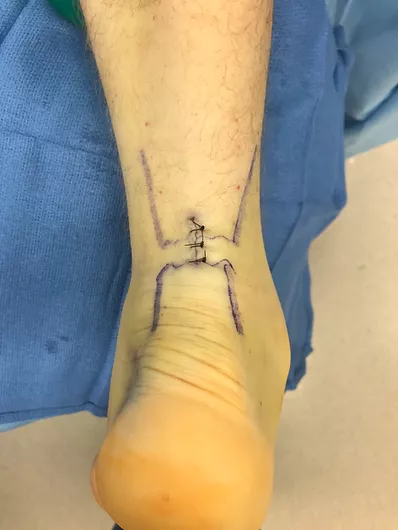 An example of a small incision (~3 cm) used to repair an Achilles tendon tear. In contrast, traditional techniques involve the use of a several inch long incision.
An example of a small incision (~3 cm) used to repair an Achilles tendon tear. In contrast, traditional techniques involve the use of a several inch long incision.
Achilles tendon ruptures are common. Either surgical or non-surgical management can be appropriate depending on your specific situation. It is important to fully explore and discuss your treatment options. Furthermore, both surgical and non-surgical treatment requires specialized physical therapy that should not be delayed.
If surgery is an appropriate option for you, Dr. Yi uses a minimally invasive technique (with a small incision) to minimize risks (such as wound healing complications and infections) associated with traditional techniques that require larger incisions.
Click here to learn more about achilles tendon ruptures.
Achilles Tendinosis/Tendonitis
Achilles tendonosis is also common among athletes. Most cases are successfully treated with non-surgical treatment strategies including: physical therapy, specific stretches, medications, injections, and more.
Surgery is an effective option if non-surgical strategies fail. Dr. Anthony Yi uses minimally invasive techniques to address Achilles tendinosis.
Depending on the location, surgery can involve removing degenerated tissue, scar, and areas of calcification. Sometimes the tendon needs to be repaired back down to it's attachment on your heel bone (calcaneus).
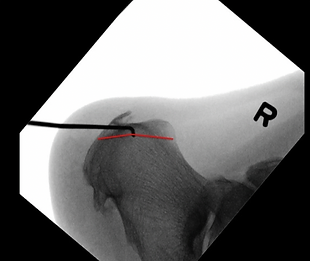
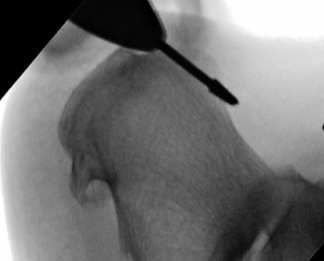
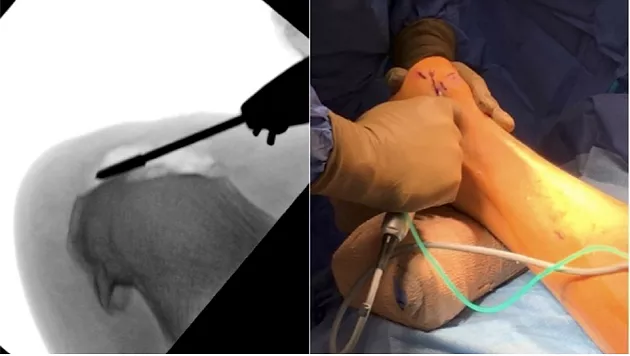 The top left picture shows a X-ray of a patient with achilles tendinosis and an associated bone spur (called a Haglund's exostosis) that was removed at the time of surgery using a special instrument that allows for surgery to be performed through minimal incisions.
The top right picture shows the same bones spur being removed.
The bottom left shows how effective the special minimally invasive surgical instrument is at removing the offending bone spur.
The bottom right shows an example of how surgery is performed through minimal incisions.
The top left picture shows a X-ray of a patient with achilles tendinosis and an associated bone spur (called a Haglund's exostosis) that was removed at the time of surgery using a special instrument that allows for surgery to be performed through minimal incisions.
The top right picture shows the same bones spur being removed.
The bottom left shows how effective the special minimally invasive surgical instrument is at removing the offending bone spur.
The bottom right shows an example of how surgery is performed through minimal incisions.
Ankle Sprains
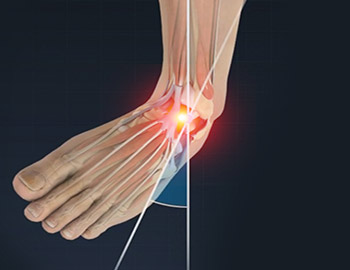 Bruising, swelling, pain, and stiffness are commonly associated with ankle sprains.
Bruising, swelling, pain, and stiffness are commonly associated with ankle sprains.
Ankle sprains are extremely common injuries among athletes. A sprain is a tear (partial or full) of a ligament (which is a strong band of tissue that connects 2 bones). Treatment generally consists of an initial period of rest followed by a therapy (to work on motion and strength) and a gradual return to activity/sport.
Most patients make a full recovery. However, there are other injuries that can occur at the time of an ankle sprain (including fractures, cartilage injuries, and more). It is important to determine the extent of your injury and to have a tailored treatment plan specific to your situation.
Ankle Instability
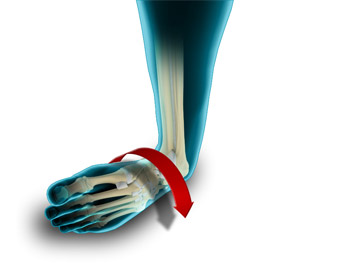
Ankle instability occurs when the ligaments around your ankle are not working as they should. Lateral ankle instability is the most common type (due to the ligament on the outside or lateral part of your ankle not functioning properly). Patients with ankle instability often have pain, swelling, and feelings of their ankle "giving way" or "turning" on them. It can result from a traumatic injury, repetitive injuries, or sometimes even due to a genetic predisposition (some people are born with looser ligaments).
Sometimes surgery is necessary to either repair or reconstruct a ligament to restore stability. Dr. Anthony Yi is well-trained in minimally invasive surgical techniques for repairing and reconstructing ligaments. He is able to perform surgery through a few incisions that are only a few millimeters long. His goal is to restore your ankle stability safely, effectively, and with a fast recovery.
Click here to learn more about ankle instability.
Exertional Compartment Syndrome
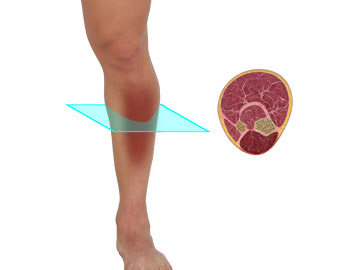
Exertional compartment syndrome occurs when the pressure in your leg rises to a level that can cause pain, numbness, or tingling. The pressure increase occurs with activity (running, climbing stairs, etc.) and returns to normal at rest. Notably, exertional compartment syndrome is different from the classic compartment syndrome, which involves a sustained increase in pressure that is potentially limb-threatening!
Surgery is a reliable method of addressing exertional compartment syndrome. The fascia (the material that surrounds muscle) is released so as to prevent the painful increase in pressure that occurs with activity. Dr. Anthony Yi uses an arthroscope (specialized small camera) to perform safe, effective, and minimally invasive surgery.
Foot & Ankle Fractures
Athletes unfortunately experience fractures involving the foot and ankle frequently. Some can be treated without surgery. Others are best treated with surgery. Dr. Anthony Yi has a strong background in treating orthopedic trauma injuries in addition to his advanced training in foot and ankle surgery.
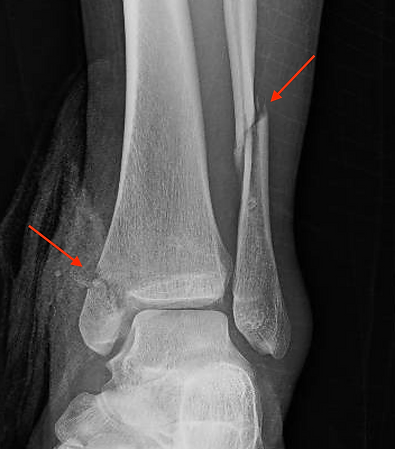
 The XR above on the left shows an ankle fracture. The arrows point to the location of the fractures.
The XR above on the right shows a lateral view of an ankle. The dotted lines outline the fractured piece of bone and the solid line shows where the fractured piece of bone should be located.
The XR above on the left shows an ankle fracture. The arrows point to the location of the fractures.
The XR above on the right shows a lateral view of an ankle. The dotted lines outline the fractured piece of bone and the solid line shows where the fractured piece of bone should be located.
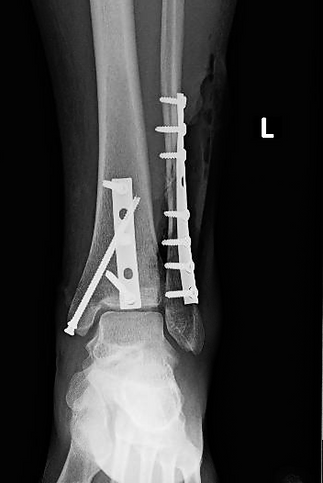
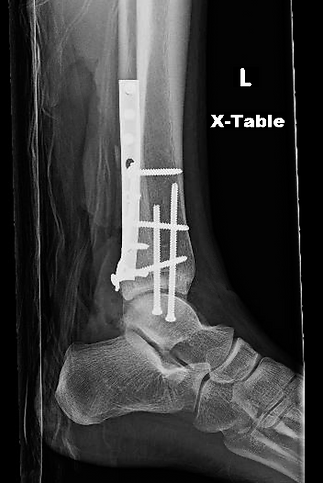 The XR above on the left shows the same ankle fracture fixed with a combination fo plates and screws.
The XR above on the right shows a lateral view of the same ankle fracture fixed with a combination of plates and screws.
The XR above on the left shows the same ankle fracture fixed with a combination fo plates and screws.
The XR above on the right shows a lateral view of the same ankle fracture fixed with a combination of plates and screws.
Click below to learn more about common foot and ankle fractures
- Ankle fracture
- Calcaneus (heel bone) fracture
- 5th Metatarsal Fracture
- Lisfranc Injury
- Pilon Fracture
- Stress Fractures
Peroneal Tendonitis
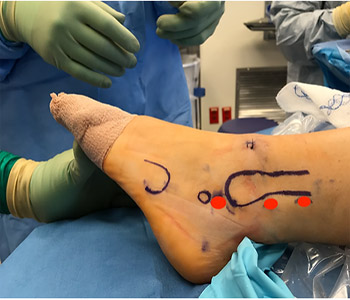 The red ovals mark the site of small incisions (that only need 1 stitch to close) that are used to perform peroneal tendoscopy (special camera and instruments used to clean up inflammed, degenerated tissue).
The red ovals mark the site of small incisions (that only need 1 stitch to close) that are used to perform peroneal tendoscopy (special camera and instruments used to clean up inflammed, degenerated tissue).
Peroneal tendonitis can affect the athlete. The peroneal tendons are located behind the fibula on the outside part of your ankle. These tendons can become irritated, swollen, degenerated, and painful.
Non-surgical treatment options include: rest, bracing, immobilization, physical therapy, and injections. Most patients find satisfactory relief with these options.
However, surgery is an option if pain and dysfunction persist. In certain cases, Dr. Anthony Yi uses a minimally invasive approach called peroneal tendoscopy (using specialized instruments and camera) to perform surgery.








